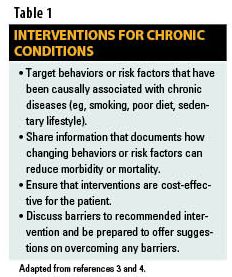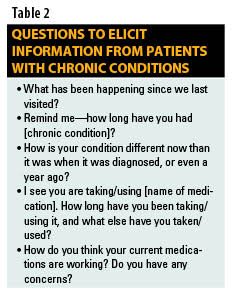Publication
Article
Pharmacy Times
Chronic Conditions: Care While We Await Cure
Author(s):
Patients with chronic conditions must manage the physical, financial, and emotional impacts of their disease states. Pharmacists can play a crucial role in helping patients cope with their chronic conditions.
Pharmacists are among the most accessible health care providers, making them pivotal in helping patients deal successfully with chronic conditions (eg, high blood pressure, arthritis, respiratory disease, high cholesterol, and mental illness). The Centers for Disease Control and Prevention predict that by 2030, approximately 171 million people will live with chronic conditions.1 Most of these patients will take prescription medications. Frequent visits by patients for new prescriptions or refills—or their failure to refill prescriptions as needed— create a window of opportunity for intervention. We can take a look at chronic diseases and how pharmacists might approach them by examining 6 quotes from famous people.

“Longevity is having a chronic disease and taking care of it.” Oliver Wendell Holmes, Associate Justice of the Supreme Court
Almost one half of Americans have persistent medical conditions that can be classified as chronic (lasting more than 3 months).1 As people age, the likelihood of having a chronic condition increases: 90% of seniors have at least 1 chronic disease, and 77% of them have 2 or more.2 When chronic diseases are initially identified, the health care focus is on controlling, and in some cases partially reversing, the condition. Concurrently, clinicians need to discuss ways to prevent predictable decline with patients. For most chronic conditions, we should be able to discuss evidence-based guidelines with patients. At the very least, members of the health care team who have the opportunity to talk with patients need to promote the interventions described in Table 1.3,4
“Don’t let what you cannot do interfere with what you can do.” John Wooden, Basketball Coach
Fortunately, most patients with chronic conditions are adults who lead normal lives; chronic conditions disable only a small portion of patients.5 Some patients develop learned helplessness (a failure to take action to make life better arising from a sense of not being in control) and live too timidly and cautiously. The antidote to learned helplessness is patient education and counseling that give patients tools to control their illnesses. To help patients achieve the highest level of functioning possible, the interdisciplinary team needs to create treatmentplans that develop patient strengths and minimize limitations.
“Every citizen who stops smoking, or loses a few pounds, or starts managinghis chronic disease with real diligence, is caulking a crack for the benefit of us all.” Mitch Daniels, Governor of Indiana
Ultimately, chronic conditions may lead to the patient’s demise or death— chronic conditions cause almost 70% of deaths in the United States.5 Those deaths will be hastened if patients engage in unhealthy lifestyles. Pharmacists need to be familiar with a portfolio of programs (including Internet programs), many of which are free, that can help patients in their communities lose weight, quit smoking, end substance abuse, and live better.
“He who has a why to live for can bear almost any how.” Friedrich Nietzsche, German philosopher
The chronically ill, and especially older women, often isolate themselves socially for a number of reasons.6,7 They may have limited mobility or lack transportation. They may find their condition embarrassing or inconvenient, or believe it is repulsive to others. These patients may have adopted inflexible lifestyles or belief systems to deal with physical, emotional, or psychological stress. They might find the constraints on their interaction with others draining. Often chronically ill individuals lose touch with their reasons for living—Nietzsche’s “why to live” disappears. Social isolation can lead to depression, anxiety, or additional health problems.
Pharmacists and pharmacy staff, accustomed to seeing patients often, may notice when patients start to become social isolates. This is a key sign of ineffective coping. This problem also affects the spousesof chronically ill people,8 especially if they become caregivers. They may be anxietystricken, be less talkative, or send someone else to pick up prescriptions. Concerned pharmacists can recommend support groups, local social agencies, or peer counselors to help. Increasingly, Internetbased interactions are also available—and acceptable—to computer-savvy elders.6
“When people have to pay more, they are less likely to adhere to their regimen.” Dana Goldman, Senior Economist, RANDCorporation
People who have chronic conditions drain our national resources, consuming 75% of our health care dollars annually.5 In an effort to deal with this burden, payors have developed various types of cost-sharing mechanisms. Studies have found that as copayments or coinsurance increase, medication possession ratio decreases significantly.9,10 With so many drug assistance programs and low-cost generic medications available, this problem can often be addressed by pharmacists who take a few minutes to ask questions about cost, look for more cost-effective alternatives, and refer patients to assistance programs.11 Pharmacists can also reduce costs by conducting a comprehensive drug regimen review and working with the patient’s health care team to eliminate unnecessary medications as well as lower doses to the most effective level. This also reduces pill burden, and increases adherence.12 Pharmacists can also stress the importance of life-sustaining and chronic drugs, and of how poor adherence can increase the cost of other health care services and overall expenditures. This will become an even more important pharmacist function as some of the recent health care legislation is enacted, and the “medical home” model is promoted.
“People with chronic disease often want more information about their illness and the various treatment options available.” Elizabeth Murray, Department of Primary Care and Population Sciences, University College, London
In the period surrounding a new and chronic diagnosis, patients seek and receive a considerable amount of information. As their conditions stabilize because of treatment interventions, medication, or lifestyle changes, p

atients tend to see clinicians less frequently; clinicians may view these patients as stable. Once the acute event that prompted care is under control, we may find patients require less of our time or process their needs more efficiently. But patients who have chronic illnesses change over time. They may stop making time for exercise, pick up or renew a bad habit, or develop comorbidities. Our knowledge and understanding of the specific chronic illness changes too, and new interventions are identified. Chronic illnesses usually wax and wane.
Because things change, patients want and need information throughout the course of their illnesses. They need clinicians to ask incisive questions—these will vary with the specific condition—and offer information about new treatment alternatives. Of utmost importance is asking open-ended questions in a way that patients will understand.13
As the recently approved health care legislation moves from theory to practice, programs around the nation will likely be establishing “medical homes.” This approach allows clinicians to provide comprehensive primary care. It promotes settings based on partnerships between individual patients, their health care providers, and, when appropriate, the patients’ families. Pharmacists, poised as they are to provide a unique service, need to be part of the medical home, especially for the chronically ill.
References
1. Chronic Care in America: A 21st Century Challenge, a study of the Robert Wood Johnson Foundation & Partnership for Solutions: Johns Hopkins University, Baltimore, MD for the Robert Wood Johnson Foundation (September 2004 Update). "Chronic Conditions: Making the Case for Ongoing Care"
2. Anderson G. The growing burden of chronic disease in America. Public Health Reports. 2004;119:263-70.
3. Gaziano TA, Galea G, Reddy KS. Scaling up interventions for chronic disease prevention: the evidence. Lancet. 2007;370:1939-46.
4. Asaria P, Chisholm D, Mathers C, Ezzati M, Beaglehole R. Chronic disease prevention: health effects and financial costs of strategies to reduce salt intake and control tobacco use. Lancet. 2007;370:2044-53.
5. Centers for Disease Control and Prevention. Chronic Diseases and Health Promotion. Available at http://www.cdc.gov/chronicdisease/overview/index.htm. Accessed May 1, 2010.
6. Holley UA. Social isolation: a practical guide for nurses assisting clients with chronic illness. Rehabil Nurs. 2007;32:51-6.
7. Beal C. Loneliness in older women: a review of the literature. Issues Ment Health Nurs. 2006;27:795-813.
8. Foxall MJ, Ekberg JY. Loneliness of chronically ill adults and their spouses. Issues Ment Health Nurs. 1989;10:149-67.
9. Yoon J, Ettner SL. Cost-sharing and adherence to antihypertensives for low and high adherers. Am J Manag Care. 2009;15:833—40.
10. Gibson TB, Ozminkowski RJ, Goetzel RZ. The effects of prescription drug cost sharing: a review of the evidence. Am J Manag Care. 2005;11:730-40.
11. Garner JB. Problems of nonadherence in cardiology and proposals to improve outcomes. Am J Cardiol. 2010;105:1495-501.
12. Smith M, Bates DW, Bodenheimer T, Cleary PD. Why pharmacists belong in the medical home. Health Aff (Millwood). 2010;29:906-13.
13. Rothman RL, Yin HS, Mulvaney S, Co JP, Homer C, Lannon C. Health literacy and
quality: focus on chronic illness care and patient safety. Pediatrics. 2009;124 Suppl 3:S315-26.
Ms. Wick is a senior clinical research pharmacist at the National Cancer Institute, National Institutes of Health, Bethesda, Maryland. The views expressed are those of the author and not those of any government agency.







